Order these records by:
Browse Collection › LC Subject Heading › 15 records found where LC Subject Heading is Real property -- North Carolina -- Durham County -- 19th century | ||
 | Letter from Thomas D. Wright to Richard Harvey Wright, September 29, 1887 Thomas D. Wright acknowledges a letter from his brother, Richard Harvey Wright. Thomas notes that public concerns about frost damage on tobacco plants in North Carolina seem unwarranted. He believes this is the best crop of tobacco since the Civil War. He discusses real estate developments and the cost of land being sold by Tilly near Alston Avenue. Thomas closes with an update on the construction of Richard's new home. | |
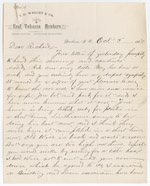 | Letter from Thomas D. Wright to Richard Harvey Wright, October 03, 1887 Thomas expresses concern for Richard's daughter, Little May, who is ill. He updates his brother on the work that Linthicum is doing to build a house for Richard Harvey Wright. He also notes that a new Building and Loan Association plans to build homes on property east of Alston Avenue. | |
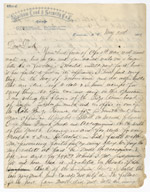 | Letter from Robert I. Rogers to Richard Harvey Wright, May 23, 1889 Robert I. Rogers, secretary of the Durham Land & Security Co. writes Richard Harvey Wright about economic news in Durham. He reports on a legal dispute over rent with "our man French." He closes by encouraging Wright to start a cotton factory. | |
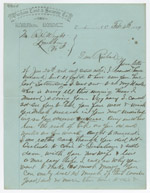 | Letter from Robert I. Rogers to Richard Harvey Wright, February 04, 1889 Robert I. Rogers, the secretary and treasurer of Durham Land and Security Company, Rogers tells Richard about real estate prices and agricultural news in Durham. | |
 | Letter from Thomas D. Wright to Richard Harvey Wright, March 20, 1889 Thomas D. Wright updates his brother, Richard Harvey Wright, Vice-President of Durham Bobbin and Shuttle Mill, on business affairs. Thomas comments that the Farmer's Alliance rented the old Reams warehouse and states that there may be a shoe factory in Durham. Eugene Morehead, a banker from Durham, died in Savannah, Georgia. | |
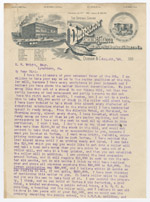 | Letter from Julian S. Carr to Richard Harvey Wright, August 06, 1890 Julian S. Carr, President of Durham Smoking Tobacco and Blackwell's Durham Tobacco Co., gives Richard Harvey Wright his vision to develop Durham and make more money. | |
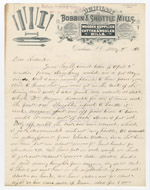 | Letter from Thomas D. Wright to Richard Harvey Wright, May 09, 1890 Thomas D. Wright acknowledges receiving Richard's letter from Hong Kong. He sends a detailed report about the fiscal situation at the Durham Bobbin and Shuttle Mill. He notes also that "Trinity College will be moved to Durham. Will locate the college, in Blackwell's Park, arrangements are now being made to commence building. Most people think Durham is on the eave of a big boom." | |
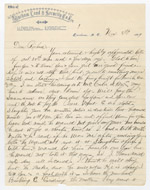 | Letter from Robert I. Rogers to Richard Harvey Wright, November 08, 1889 Robert I. Rogers shares news about real estate in Durham, the rise in tobacco prices and the upcoming meeting of Blackwell's creditors. He also comments on the smaller turn out for the evangelical preacher Sam Jones, who held his revival in Durham. | |
 | Letter from Robert I. Rogers to Richard Harvey Wright, July 26, 1890 Robert Rogers, secretary and treasurer for Durham Land and Security, writes to Richard Harvey Wright about the renewal of the graded school contracts. He states that William Guthrie authorized the contract. | |
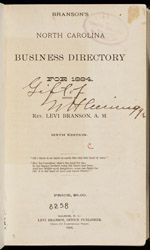 | Branson's North Carolina business guide This section of the guide contains physical attributes, land values, livestock values, taxes, and population statistics for Durham County. Branson notes that Durham County's population was 13,000, of which 8,500 were white and 4,500 were black. Also provided are the towns that had a post office, as well as county officers, court hearings, townships, magistrates, churches, pastors, and denominations. For individuals, Branson lists the name, nearest post office, and occupation. Edward James Parrish and Blackwell's Warehouse bought advertising space in the guide. | |
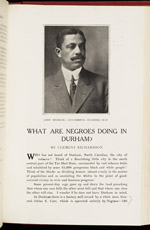 | What are Negroes doing in Durham? Essay by Clement Richardson in the Southern Workman highlighting the achievements of the African American community in Durham in the early 1910s. Richardson focuses on the contributions of black entrepreneurs and professionals including E. R. Merrick, Robert Fitzgerald, Stuart Lynn Warren, John Merrick, Dr. A. M. (Aaron McDuffie), R. H. Clegg, W. G. Pearson, J. S. Scarborough, E. W. Cannady, Dr. F. D. Page, Peyton H. Smith, P. W. Dawkins, Jr. and others. | |
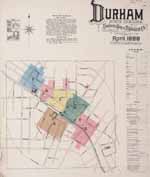 | Sanborn Fire Insurance Map, Durham, North Carolina, 1888 This fire insurance map by the Sanborn Map & Publishing Company provides a detailed look at the commercial buildings that stood within the town limits of Durham, North Carolina in 1888. The map contains an index page to city streets and the location of the county courthouse, jail, churches, manufacturers, tobacco warehouses and prizing establishments, mills, stables, and other enterprises. The map's legend provides details about the construction of the buildings (whether they have been built from stone, brick or wood) as well as details about the number of stories and windows. The map also lists the type of commercial enterprises housed in various structures. For larger businesses, the cartographer details the number of workers employed and describes the establishments’ fire-fighting capabilities. Scale ca. 1" = 50 feet. A georeferenced version of this map is also available on the Digital Durham website. | |
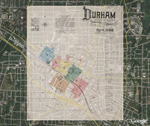 | Sanborn Fire Insurance Map, Durham, North Carolina, 1888 (Google Earth Overlay) Beta Using the Google Earth web application, we have created semi-transparent images from the original set of Fire Insurance Map of 1888 and placed these over satellite imagery of present-day Durham. Because of a paucity of information of some buildings presented on pages 6 and 7, we provide an approximate location for the Bobbin and Shuttle Mill, the Durham Cotton Manufacturing Company, and J.W. Allen's Tobacco Prize House. | |
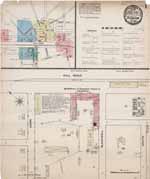 | Sanborn Fire Insurance Map, Durham, North Carolina, 1884 This five-page fire insurance map by the Sanborn Map & Publishing Company provides a detailed look at the commercial buildings that stood at the center of Durham, North Carolina in 1884. The map contains an index page to city streets that identifies the location of churches, tobacco warehouses, and other enterprises. A key to the maps provides details about the construction of the buildings (whether they have been built from stone, brick or wood) as well as details about the number of stories and windows. The maps also list the type of retail enterprises housed in various structures. For larger businesses, the cartographer details the number of workers employed and describes the establishments’ fire-fighting capabilities. Scale ca. 1" = 50 feet or [ca. 1:600]. A georeferenced version of this map is also available on the Digital Durham website. | |
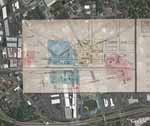 | Sanborn Fire Insurance Map, Durham, North Carolina, 1884 (Google Earth Overlay) Beta Using the Google Earth web application, we have created semi-transparent images from the original set of Fire Insurance Map of 1888 and placed these over satellite imagery of present-day Durham. Because of a paucity of information of some buildings presented on pages 6 and 7, we provide an approximate location for the Bobbin and Shuttle Mill, the Durham Cotton Manufacturing Company, and J.W. Allen's Tobacco Prize House. This fire insurance map by the Sanborn Map & Publishing Company provides a detailed look at the commercial buildings that stood within the town limits of Durham, North Carolina in 1884. The map contains an index page to city streets and the location of the county courthouse, jail, churches, manufacturers, tobacco warehouses and prizing establishments, mills, stables, and other enterprises. A key to the maps provides details about the construction of the buildings (whether they have been built from stone, brick or wood) as well as details about the number of stories a... | |
digitaldurham@duke.edu · About this site · Copyright © 2001 - 2006. Trudi J. Abel. All Rights Reserved.
The copyright interest in the material in this digital collection has not been transferred to the Digital Durham project. These text and images may not be used for any commercial purpose without the permission of the David M. Rubenstein Rare Book & Manuscript Library and the Digital Durham Project. Copyright permission for subsequent uses is the responsibility of the user.
